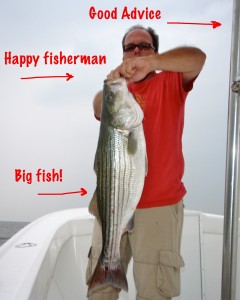 No man, after catching a big fish, goes home through an alley. – Ancient Chinese Proverb
No man, after catching a big fish, goes home through an alley. – Ancient Chinese Proverb
Maybe you’ve heard someone recite another old saying about “the three stages of a fisherman’s life.” It goes something like this: The first stage is when the angler’s main objective is to catch as many fish as possible, the second stage is when the angler only searches for the larger fish, and the third and final stage is when size doesn’t matter and the capture is unimportant, but satisfaction comes from the way the angler tricks the fish. I usually nod my head in agreement when I hear that, but c’mon now, I don’t know one single fisherman who, when given a choice, doesn’t cast toward the biggest fish in the pond. We can wax poetic about the joys of baptizing ourselves in the boundless beauty of nature, and we can sing the praises of that peaceful solitude we find out on the open water, but screw it – the bottom line is, no matter how we are fishing, we want to catch a whopper! In this third and final segment of the Gimme a Breaker series, we’re looking at ways to get the lunkers out of surface blitzing Chesapeake rockfish.
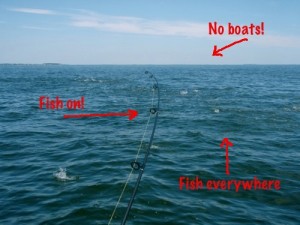 I hope you’re getting out there and enjoying some of the intense blitz action that’s going on right now in the Mid-Chesapeake Bay. In the first segment of this series I wrote about how to use the C+B/HB = BF formula to find breakers. Uh huh, so you got that, right? (It’s current plus bait over hard bottoms equal breaking fish.) Last week I mentioned some of the birds we encounter over blitzing fish. Easy, peasy! The final step is sorting through the fray to get to the bigger fish. Nothing to it! As you surely know, it’s not hard to catch fish once you find the blitz and start casting. I’ve joked that it’s sometimes so easy that you can catch them with a buzzard feather and a coat hanger, but catching the bigger ones, or maybe even landing a trophy summer striper is a little bit more challenging. Here’s something to remember above all else – when you’re in breakers, the biggest impediment to catching big fish is catching little fish.
I hope you’re getting out there and enjoying some of the intense blitz action that’s going on right now in the Mid-Chesapeake Bay. In the first segment of this series I wrote about how to use the C+B/HB = BF formula to find breakers. Uh huh, so you got that, right? (It’s current plus bait over hard bottoms equal breaking fish.) Last week I mentioned some of the birds we encounter over blitzing fish. Easy, peasy! The final step is sorting through the fray to get to the bigger fish. Nothing to it! As you surely know, it’s not hard to catch fish once you find the blitz and start casting. I’ve joked that it’s sometimes so easy that you can catch them with a buzzard feather and a coat hanger, but catching the bigger ones, or maybe even landing a trophy summer striper is a little bit more challenging. Here’s something to remember above all else – when you’re in breakers, the biggest impediment to catching big fish is catching little fish.
CLT Big Fish in Breakers Tip #1: Use Big Lures – When I find fish breaking on the surface, the first lure I throw is a top-water plug, and I don’t mean a wimpy one either. A full-size five-inch, heavy duty, hard core Stillwater Smack-It ought to do it, either that or a Lonely Angler Holo, or I might throw a big brightly colored Super Spook if winds are calm. Whatever I throw, you can bet it’s gonna be a great big plug that makes a great big splash, with great big hooks. The stock hooks that come on the Smack-Its are fine, but I usually have to up-size the hooks on a Heddon spook. Little fish will chase and hit your big plug, but they’re less likely to get stuck when you use big hooks. That leaves room for the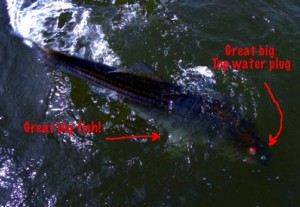 bigger fish to attack.
bigger fish to attack.
You really don’t need a back hook on your plugs. Stripers, especially the bigger ones, almost always hit the lure head first. If you insist, you can just cut the trebles down to one single hook. The only good purpose of the back hook on a top-water striper plug is to deliver the feathers, or whatever other kind of flash you like. Unless you just want to catch small fish, there’s no reason to use a plug less than 5-inches long. Unless I have kids on the boat, or on the rare occasion that I find myself fishing with people who are really struggling to catch something, I never throw anything smaller.
The same goes for soft plastics. If fish aren’t breaking but they are still hanging around in the general area, I switch over to a soft-plastic jig with a light jig head and a wide-gapped hook. I mash the barbs on the hook flat so I can release the fish fast and cast back out quickly toward the bigger ones. I start with 6-inch BKDs and move up to 10-inch as soon as I notice that there are some big fish in a blitz. I stay with soft plastics even after the time of year when those lure-munching piranha bluefish arrive, but I usually switch over to the kind that are made of material that is resistant to bite-offs. Just like with my top-water plugs, I don’t want a lure that is less than 5-inches long. Anything will catch fish in breakers, but unless you want to spend all your time reeling in and taking off little fish, go with big lures.
CLT Big Fish in Breakers Tip #2: Bait Size Matters – The first thing I do when I roll up on a school of blitzing fish is look to see what size bait they are chasing. Sometimes the size of the surface splashes can be misleading. Just because there are little fish feeding on the surface doesn’t mean there aren’t big ones around, so don’t judge so much by the fish you see breaking. Instead, look hard at the bait they’re chasing. Big fish usually won’t waist their energy chasing tiny glass minnows. By tiny, I mean no longer than the size of your fingertip. Big fish are looking for a bigger bite, usually minnows that 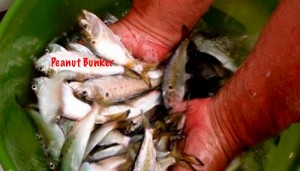 are at least an inch long or longer.
are at least an inch long or longer.
On the flip side, you can sometimes find big bait near the surface with no fish blitzing on them. This is especially true with peanut bunker. Even when there aren’t fish eating them, pay attention when you find them because the fish might move in on that bigger bait at any moment. At least make a mental note of where you saw them, the fish will be there eventually. Peanut bunker over a live hard oyster bottom when the current is flowing almost always equals nice summer breakers. When you find a school of breakers on bunker, your chances are good for getting good fish.
CLT Big Fish in Breakers Tip #3: Little fish like little fish – And, big fish like big fish, and bluefish will eat each other if they don’t run in the same size schools. Fish of a feather flock together – umm, well you know what I mean. Once you’ve figured out that you’re in little fish, there’s no reason to waste your time. Move on. When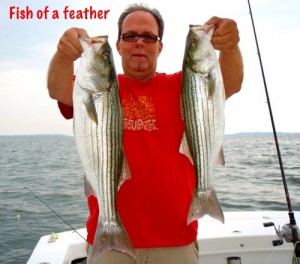 it comes to rockfish, that old saying about never leaving fish to find fish is WRONG. Trust me, when conditions are right for fish to blitz at one spot, they’re also tearing it up at another spot nearby. Don’t waste your time reading bad cliches or harassing little dinks. Strike while the iron is hot – get off those dinks and go!
it comes to rockfish, that old saying about never leaving fish to find fish is WRONG. Trust me, when conditions are right for fish to blitz at one spot, they’re also tearing it up at another spot nearby. Don’t waste your time reading bad cliches or harassing little dinks. Strike while the iron is hot – get off those dinks and go!
CLT Breakers Tip 4: Go below and beyond – In the first segment of the series I described how to position the boat in a manner that allows you to drift over the fish and/or lets the fish come to you. Don’t give up immediately after you’ve drifted through the breakers, because that’s often the best time to tie into a big one. Big stripers often hang around downstream of a feeding frenzy. They’re letting the smaller fish do all the hard work and just lazily waiting around for the scraps to fall their way. It’s not too much different from fishing in a chum slick. Fishing below and downstream is especially effective when there are bluefish in the blitz because they chop up the bait and get even more chum in the water. Also, remember that downstream means down current, not down wind.
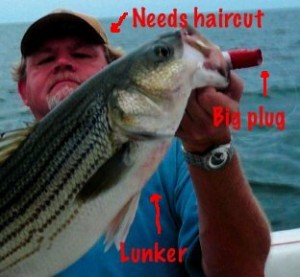 CLT Big Fish in Breakers Tip #5: Shhh, dammit – Enough said!
CLT Big Fish in Breakers Tip #5: Shhh, dammit – Enough said!
CLT Big Fish in Breakers Tip #6: Chase birds, not boats – I see it time and again, a half-dozen boats stacked up over a pod or two of breakers and everyone catching dinks. Unless I’m absolutely desperate to catch a fish, I usually pass right on by. Why? See CLT Big Fish in Breakers Tip #5. People get excited when they see blitzing fish. It’s inevitable that they shout, laugh, stomp, chuckle and choke. I do it too. I can’t help it. When there are a lot of boats around, the big fish recognize the commotion and they usually don’t bite. Also, a lot of anglers won’t be as savy about bait size and school size and how fish of a feather… well, you know. They might be perfectly happy catching baby fish, or maybe they’re hoping against the odds that a big one might be lost in the middle of those 14-inchers! Increase your chances for bigger fish by moving on a little farther to look for a school that you can have all to yourself.
CLT Big Fish in Breakers Tip #6: X marks the spot – Once you find a school of bigger fish, or land a couple of nice ones out of a blitz, mark that spot so you can come back to it. A GPS system makes it easy. It’s not 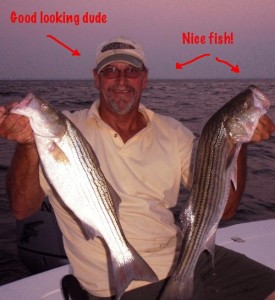 unusual to find fish at the same place a little later or on subsequent days. Similarly, pay close attention to where you are on the tide cycle so you can check that spot again when the current is similar. This tip goes for any fishing, not just chasing breakers.
unusual to find fish at the same place a little later or on subsequent days. Similarly, pay close attention to where you are on the tide cycle so you can check that spot again when the current is similar. This tip goes for any fishing, not just chasing breakers.
Results!
I put most of these tips to use this past week, fishing a couple of times with my friend Joe, and getting out once with my brother, Brent. On both trips we pulled off pod after pod of small stripers looking for bigger ones. Sometimes we found them easily, sometimes we had to look hard, but the end result was always the same – nice fish. Brent even landed a personal best summer trophy on, you guessed it, a big top-water plug. Good luck if you get out there. Fishing is good right now. Since you’re going to catch fish anyway, and you’re already in that third stage of catching them how you want to, you might as well catch a big one, right? Got any tips of your own for getting the diamonds out of the duds?




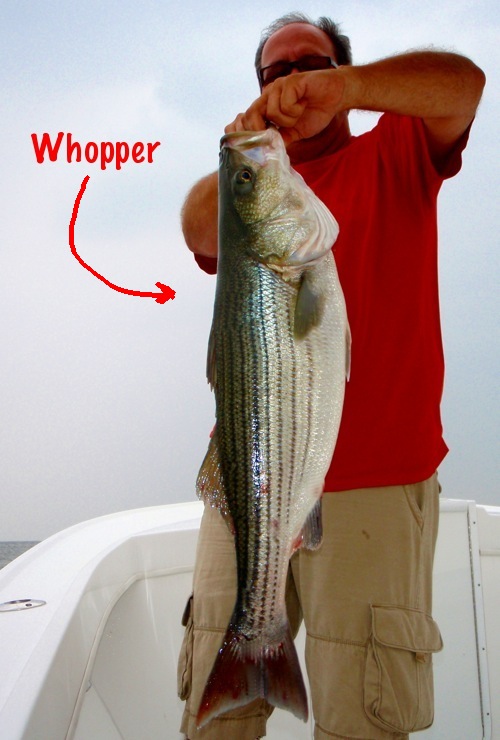
I have one tip, read CLT. This report is both funny and awesome. I’m saying to myself, why didn’t I think of that!
Hey Jamie, you starting to notice that we are the only ones he is not putting on BIG fish. What do you think is going on here.
Fish of a feather flock together. I have to remember that one. These tips really make me want to go fishing.
Atta way Dr. Uncle Brent!
YOZURI MAKES SOME NICE BIG TOP WATER LURES WITH WIDE MOUTHS AND MAKE A BIG SURFACE SPLASH.WHAT ABOUT USING SOME OF THE BIGGER STICK BAITS
“Hey Jamie, you starting to notice that we are the only ones he is not putting on BIG fish. What do you think is going on here.”
You know Rich, I was thinking the same thing..this guy wsa a “non-fishing black sheep” of the family and he got a whopper?….What is going on around here?…
I am writing to say thank you. My friend and I followed your advice to the letter yesterday. We came out of South River and started on the East Side. I printed the hard bottom map so we could follow along. My buddy thought I was crazy until we came right up on a hundred birds, but they were all small bluefish and little rock. I told him what you said about fish ususally braking at more place than one at the same timee so we went crossed some deep water to another oyster bar and there they were. This time they were all keepers and my friend caught on that was 27 on his big plug. I hope I see you out on the water sometime so I can thank you in person. I am more confident than ever now that I can do this lighttackle.
Shawn-I’m sure you didn’t weren’t thinking of me when you wrote this but it is dead on to my report from last week. Thanks for the tips. While I obeyed a lot of the rules there are a few that I didn’t. I will from here out. The biggest ones are also the tougest ones. Big lures, and leave the little ones and find the bigger ones. I’ve had my fun bailing dinks now I want to find bigger ones! Thanks for the advice and one of these days I’ll see ya out there.
Thanks for the great information here! Thanks for the couple of days fishing last week… “leaving small fish to find better ones” is sometimes hard to do… but well worth it! One thing I do to enlarge the size of some of my baits is to remove the trebles…and add one of my “big ugly” flies to the rear of thr plug or spoon.In minutes I can change a 5″ plug into a 9″ monster with extra flash and tail movement from the fly.
Hey Shawn,
Do you think it is a little too early to try some shallow water topwater spots north of the bridge tomorrow or should we just head south tomorrow evening?
Yeah, TW has been off this summer and I havn’t found much in the upper bay shallows except for the SP and it’s hit and miss there and only at first or last light. South is very good now. Good luck tomorrow.
I can’t help but think of Alice’s restaruant when reading this. 8X10 glossy photos with circles and arrows….etc. Nice report Shawn, always like stoppin in here from time to time and checkin out your recent exploits. Cheers.
Hey Kimbro, I noticed some of the guides are promoting little bucktails and trailers on topwater lures. That seems opposite from the advice you’re giving. What’s up with that?
Good question, Allen. I think we’re talking apples and oranges. A guides job is to put their clients on fish, and some (not all) are happy with any fish, no matter how big. You also have to remember that their clients have varried skill levels, and it’s an accomplishment for some people just to get a fish in the boat. In this CLT post I’m looking at techniques to get the bigger fish out of the breakers.